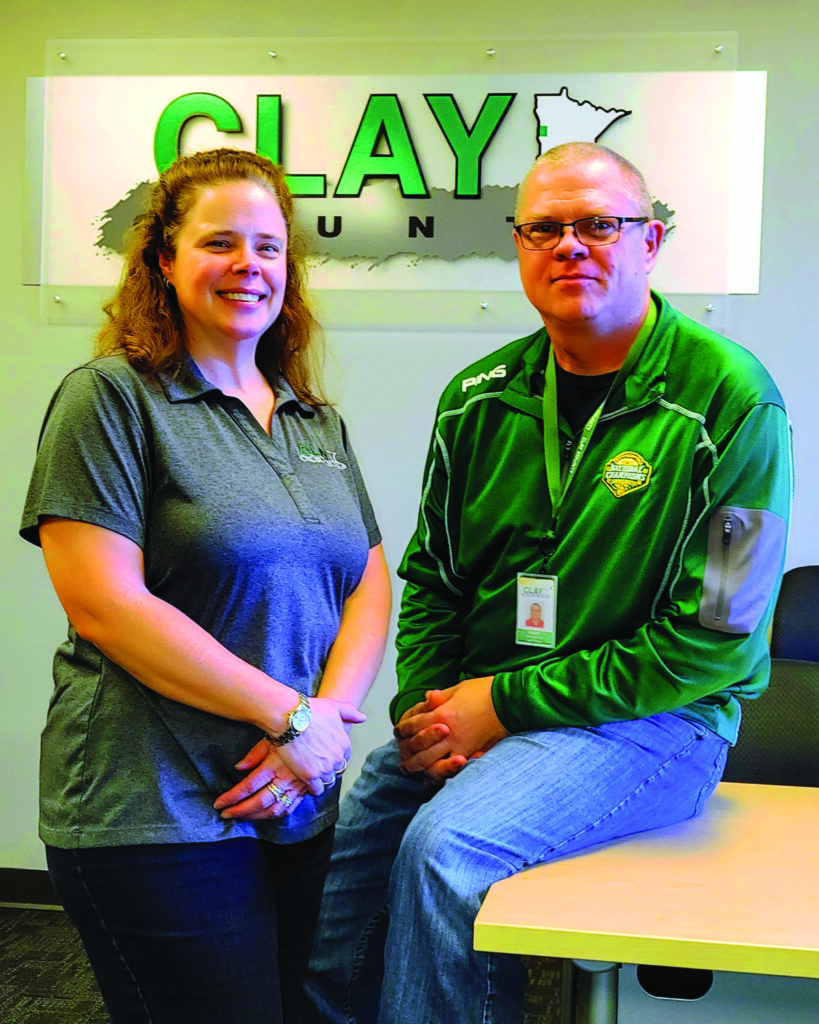
Cory Bang (at right), director of the Clay County Solid Waste Department, and Shannon Thompson, resource recovery technician. (Photo/Nancy Hanson.)
Nancy Edmonds Hanson
Local leaders have been dreaming about garbage for the last nine years. On Tuesday, Jan. 31, that vision finally opens its doors — a modern, consolidated facility streamlined to handle more than 25,000 tons of solid waste that are collected every year from the city of Moorhead and the rest of Clay County.
Residents are invited to take a first look at the ribbon-cutting ceremony scheduled for 2:30 that afternoon. They’ll be able to take a closer look at the enormous structure at the corner of 34th Street and 15th Avenue North — 44,000 square feet, just over one acre of indoor space dedicated to handling the community’s garbage.
The center, says Clay County solid waste director Cory Bang, draws together the fractured and sometimes confusing city and county operations that have long dealt with the mountain of garbage discarded by residents. Today, Moorhead’s fleet of garbage compaction trucks empty grey bins that residents wheel to the curb on a weekly basis, then deliver it all to the transfer station at 2727 Highway 10. Commercial and apartment dumpster waste makes the same trip to the tipping station, where 16,000 tons of what residents have thrown away is loaded into semi trailers and hauled 20 miles to the 182-acre county landfill southwest of Hawley. About 9,500 tons goes 40 miles farther to the Prairie Lakes Facility, where it’s burned to generate steam to run a dog food and a dairy plant.
But the busy transfer station on Highway 10 — where residents can also drop off their own trash — is just part of the present system. Hazardous household waste goes to a separate site next to the transfer station. It generally accepts household, lawn and garden chemicals as well as paints, used motor oil and other liquids, totaling 57 tons a year. Electronics (computers, TVs, fluorescent bulbs, holiday lights and more) go to yet another site, the county electronics shed on 15th Avenue North behind the DMV building; that program collects 124 tons annually.
The hitch, though, is that drop-offs at both of these locations have been strictly limited — only two or three days a week for the hazardous waste and two hours on Tuesdays for electronics.
No more! The new Resource Recovery Center, will replace all three destinations when it opens on Monday, Feb. 6. According to Shannon Thompson, the center will be open to Clay County residents from 8 a.m. to 4 p.m. Monday through Friday and from 8 a.m. until noon on the first and third Saturdays of the month.
Compactor trucks loaded with solid waste — both from Moorhead and Fuchs Sanitation, the commercial firm that handles waste collection in the smaller cities of Clay County — will enter the vast south building on the new site. There, the waste they’ve collected goes onto the tipping floor, where it is moved into semi trailers that drive into a sunken tunnel for loading.
Residents will enter the facility along a different route. First stop: the scale house, where an attendant will make a note on their loads and give them a ticket. They will drive to the appropriate spot on the north end of the building and unload their trash — including furniture, appliances, batteries, household chemicals, strings of lights, bulbs and tires. Then they’ll loop back to the scale house and pay the same fees that are currently charged at the landfill.
The path to the convenient state-of-the-art waste-handling center has had its ups and downs, Bang notes. Planning began in 2014, then stalled for two years until Clay County was awarded a $6000,000 state grant for its design and engineering. At the time, the project was estimated to cost $10 million. A final design was submitted to and approved by the Minnesota Pollution Control Agency in 2017.
Then … crickets. “Nothing much happened for two years,” Bang recounts.
It came to life again in 2020 with a $7.500,000 state CAP grant. “It was supposed to cover 50% of the cost with a 50% local match,” Bang says. The estimate was now $14.5 million. But the pressure on pandemic-era pricing continued to squeeze the cost of materials, along with the availability of labor.
Nevertheless, officials celebrated when ground was finally broken in 2021. Now, with the end in sight, Bang estimates the bill for the completed project is about $25 million. That includes FF&E — furniture, fixtures and equipment — including two new transfer trailers, two tractors a new hook truck for roll-offs and a forklift.
Despite the size of the facility, it operates with a lean staff, including five county employees and three or four who work for the city. Only one additional worker has been added to operate the far larger, far more efficient facility.
Bang and Thompson say the center’s size was calculated with continued growth in mind. “We didn’t build it expecting that waste collection numbers would go backwards,” Bang laughs.
Thompson predicts that the opening of the Resource Recovery Facility is going to ease residents’ long-standing frustration with the fragmented services of the past. “We’ll have better hours, better space and a convenient facility that’s big enough,” she says. “All waste materials are going to be accepted in one place.”
She adds, “If it’s in your house and you can’t get rid of it here, you shouldn’t have it there in the first place.”


